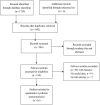Associations Between Six Core Processes of Psychological Flexibility and Functioning for Chronic Pain Patients: A Three-Level Meta-Analysis
- PMID: 35898622
- PMCID: PMC9309299
- DOI: 10.3389/fpsyt.2022.893150
Associations Between Six Core Processes of Psychological Flexibility and Functioning for Chronic Pain Patients: A Three-Level Meta-Analysis
Abstract
The previous research showed contradictions in the relationships between psychological flexibility processes and functioning. This meta-analysis is the first to provide a comprehensive meta-analysis of the associations between six core processes of psychological flexibility and functioning among chronic pain patients. Four databases were searched (PsycINFO; PubMed; CINAHL; Web of Science) along with reference lists. Thirty-six cross-sectional studies were included (7,812 chronic pain patients). A three-level meta-analytic model was used to examine the associations. The publication bias was assessed with the Egger test, funnel plot, and p-curve analysis. Significant associations were found between functioning and six processes of psychological flexibility (i.e., acceptance, defusion, present moment, committed action, self as context, and values). Except for the relationship between defusion and functioning, the relationships between the other five psychological flexibility processes and functioning were all moderated by domains of functioning. No moderators were found regarding age, percentage of females, country, or type of instrument used to measure functioning. These findings may carry significant implications for chronic pain patients and clinical workers. It might be more effective to focus on functioning-related psychological flexibility processes rather than all therapy packages if the relationships between functioning and specific processes of psychological flexibility were better informed. Limitations were also discussed.
Keywords: acceptance; acceptance and commitment therapy; chronic pain; meta-analysis; physical functioning; processes of psychological flexibility; psychological functioning.
Copyright © 2022 Ding and Zheng.
Conflict of interest statement
The authors declare that the research was conducted in the absence of any commercial or financial relationships that could be construed as a potential conflict of interest.
Figures













Similar articles
-
Which outcome variables are associated with psychological inflexibility/flexibility for chronic pain patients? A three level meta-analysis.Front Psychol. 2022 Dec 6;13:1069748. doi: 10.3389/fpsyg.2022.1069748. eCollection 2022. Front Psychol. 2022. PMID: 36562078 Free PMC article.
-
Psychological flexibility and traditional pain management strategies in relation to patient functioning with chronic pain: an examination of a revised instrument.J Pain. 2007 Sep;8(9):700-7. doi: 10.1016/j.jpain.2007.04.008. Epub 2007 Jul 5. J Pain. 2007. PMID: 17611162
-
A Confirmatory Factor Analysis of Facets of Psychological Flexibility in a Sample of People Seeking Treatment for Chronic Pain.Ann Behav Med. 2016 Apr;50(2):285-96. doi: 10.1007/s12160-015-9752-x. Ann Behav Med. 2016. PMID: 26608280 Free PMC article.
-
Preliminary investigation of the associations between psychological flexibility, symptoms and daily functioning in people with chronic abdominal pain.Br J Pain. 2021 May;15(2):175-186. doi: 10.1177/2049463720926559. Epub 2020 Jun 3. Br J Pain. 2021. PMID: 34055339 Free PMC article.
-
A psychological flexibility conceptualisation of the experience of injustice among individuals with chronic pain.Br J Pain. 2014 May;8(2):62-71. doi: 10.1177/2049463713514736. Br J Pain. 2014. PMID: 26516537 Free PMC article. Review.
Cited by
-
Measurement of psychological inflexibility: an examination of the psychometric properties of the AAQ-3 compared to AAQ-II.BMC Psychol. 2023 Sep 30;11(1):300. doi: 10.1186/s40359-023-01318-9. BMC Psychol. 2023. PMID: 37777799 Free PMC article.
-
Personality and Pain Outcomes in Rheumatic Disease: The Mediating Role of Psychological Flexibility.Healthcare (Basel). 2024 May 25;12(11):1087. doi: 10.3390/healthcare12111087. Healthcare (Basel). 2024. PMID: 38891162 Free PMC article.
-
Flexibility and inflexibility in an Iranian sample: psychometric properties of MPFI based on the Hexaflex model.BMC Psychol. 2024 Jan 18;12(1):34. doi: 10.1186/s40359-024-01531-0. BMC Psychol. 2024. PMID: 38238867 Free PMC article.
-
Which outcome variables are associated with psychological inflexibility/flexibility for chronic pain patients? A three level meta-analysis.Front Psychol. 2022 Dec 6;13:1069748. doi: 10.3389/fpsyg.2022.1069748. eCollection 2022. Front Psychol. 2022. PMID: 36562078 Free PMC article.
-
The Mediating Role of Psychological Flexibility and Inflexibility Between Impulsivity and Opioid Misuse in People With Chronic Noncancer Pain.Eur J Pain. 2025 Jul;29(6):e70048. doi: 10.1002/ejp.70048. Eur J Pain. 2025. PMID: 40418088 Free PMC article.
References
-
- Brooks JM, Iwanaga K, Chiu CY, Cotton BP, Deiches J, Morrison B, et al. Relationships between self-determination theory and theory of planned behavior applied to physical activity and exercise behavior in chronic pain. Psychol Health Med. (2017) 22:814–22. 10.1080/13548506.2017.1282161 - DOI - PMC - PubMed
-
- Esteve R, Marcos E, Reyes-Pérez Á, López-Martínez AE, Ramírez-Maestre C. Pain acceptance creates an emotional context that protects against the misuse of prescription opioids: a study in a sample of patients with chronic noncancer pain. Int J Environ Res Public Health. (2021) 18:3054. 10.3390/ijerph18063054 - DOI - PMC - PubMed
Publication types
LinkOut - more resources
Full Text Sources

